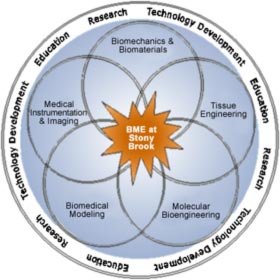BME Research Overview
- Research Programs
- Research Partnerships
- Students Reap the Benefits
- Unique Technologies Under Development
Welcome
Our faculty are involved in cutting-edge research in the areas of biomechanics, biomaterials, bioinstrumentation, molecular biomedical engineering, tissue engineering, medical imaging and biomedical modeling. This work ranges from quantifying the dynamics of the cell membrane, to the evaluation of therapeutics in the clinic and provides the student the opportunity to contribute to our understanding of the etiology of disease, as well as design new modes of treatment. Indeed, we are fully committed to bringing science from the bench-top to the bedside.

These disciplines thrive through active interdisciplinary collaborations between the faculty in the College of Engineering and Applied Science (CEAS), the School of Medicine (SOM) and the College of Arts & Sciences, all of which are in close proximity.
Unique BME Research Programs
Our programs in biomedical engineering are designed to encourage the continuum of basic science through technology development, reflects our commitment to the integration of biology and engineering in both in education and research. Our curriculum, courses, colloquia, seminars, individual research and faculty-student interactions all reflect the very essence of this program, emphasizing the integration of biology and engineering, as well as research and education, giving students both depth and breadth of knowledge in this area. Indeed, students reap the benefits of exposure to a vigorous, cross-disciplinary graduate training and research environment.
Strong Research Partnerships
In 1997, the University became the manager for Brookhaven National Laboratory (BNL), one of our country’s strongest federal research labs. That the lab is 15 miles from campus, interactions have thrived. As might be expected, a great deal of unique research instrumentation is available at BNL, making it a wonderful resource for both faculty and students. Strengthening this relationship, six faculty at BNL became early members of our graduate program in biomedical engineering (Professors Volkow, Springer, Gatley, Dilmanian, Fowler and Diaz), representing a significant portion of their world renowned Medical Department. Several graduate students have already taken rotations in the labs, with access to the National Synchrotron Light Source, 4T magnets, SPECT, PET, fMRI and other state of the art imaging equipment.
See the complete listing of affiliated facilities.
Students Reap the Benefits
This ongoing biomedical engineering research, combined with unique facilities at the University, have helped distinguish Stony Brook as a superb resource for education in both the engineering and health sciences. With both undergraduate and graduate degree programs available, students can readily take full advantage of these invaluable intellectual and physical resources.
The faculty responsible for the design and implementation of the graduate program are active in, and committed to, interdisciplinary training and research in biomedical engineering. The graduate curriculum addresses these issues, beginning with the a unique core set of courses which stresses engineering principles in cell, tissue and organ biology and emphasizing a research program that truly crosses engineering an biology disciplines. The philosophy behind the curriculum is to prepare the student in an interdisciplinary environment to enter academia, industry or government.
Please read the compiled list of our specific research pathways.
Unique Technologies Under Development
As evidence of our ability to bridge basic to applied science, BME faculty are in late stage development of several unique technologies, including:
- a non-invasive biomechanical intervention for osteoporosis (Rubin)
- tissue engineering to accelerate wound repair (Clark, Xu & Taichman)
- unique biomaterials for controlled drug and gene delivery to bone, skin, cartilage and heart (Chu, Hsiao & Chen)
- finite element optimization of cardiac valve prostheses (Bluestein & Krukenkamp)
- 3-D virtual colonoscopy (Kaufman & Liang)
- a semiconductor based data acquisition system for DNA sequencing (Luryi)
- design and fabrication of bioactive polymer thin films (Rafailovich)
- a scanning ultrasound diagnostic of bone material properties (Qin)
- informatics algorithms for gene regulatory analysis (Glimm, Skienna & Zhu)
- high resolution MRI, PET and SPECT instrumentation for the evaluation and targeted treatment of brain, heart and lung dysfunction (Springer, Button, Gindi, Reinstein, Diaz, Dilmanian & Volkow)
